ESCAPE
Gong rock songs in the stone hills of the Great Karoo
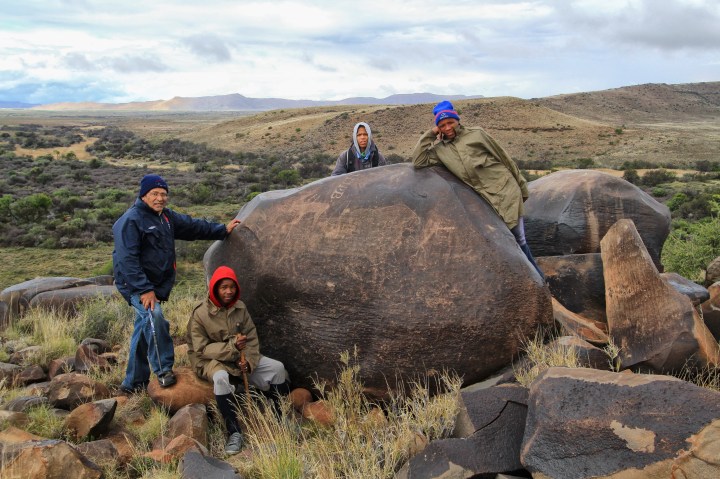
On the koppies around Nelspoort lies history written in rock – with an ancient soundtrack.
Spring, 2002: From a hillside, you look down into a long, shallow valley.
A railway line and a dry rivercourse run beside one another, leading into the vanishing distance. A bulky flat-topped hill behind you looms over the landscape. Just over a ridge on the right is the little railway settlement of Nelspoort.
Back in the 1850s, missionary David Livingstone was already talking of the Karoo as the perfect place to cure lung diseases; and so tuberculosis sufferers – in the days when it was still called consumption – headed for this dry land.

The terrain around Nelspoort consists of gentle flat-topped hills with engraved dolerite rocks, interspersed with interesting Karoo plants and grasses. Image: Chris Marais
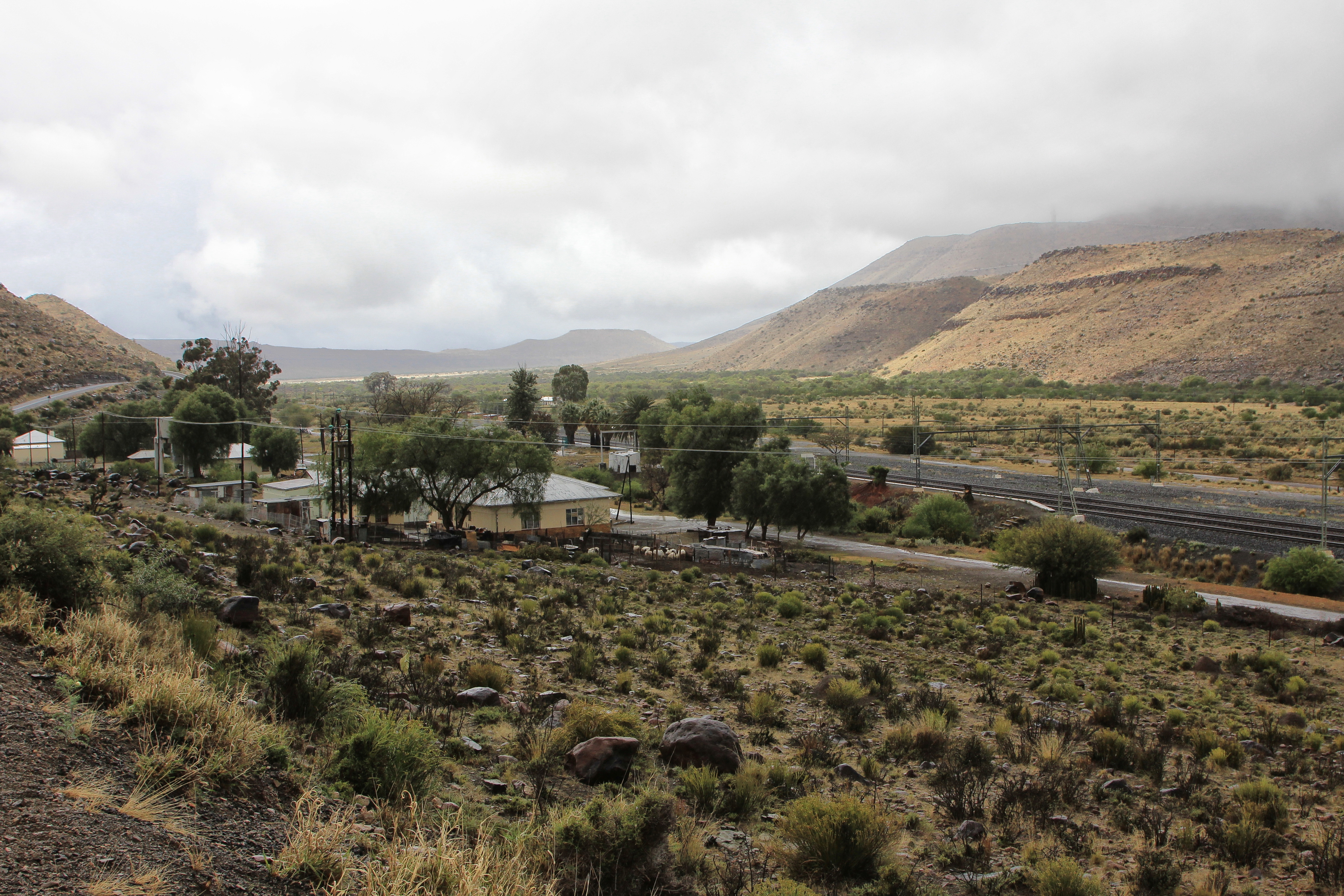
In the late Victorian era, Nelspoort Station used to buzz with visitors arriving to take healing from the fresh Karoo air. Image: Chris Marais
The healing Karoo
“Many sufferers were healed, but for others it was too late. On the farm Courlandskloof near Nelspoort, a Swedish man called Petersen carved a homesick poem onto a rock just before his death from lung disease,” writes Karoo historian Rose Willis in an edition of Rose’s Roundup, her well-loved regular newsletter.
“Despite being so sick, he climbed the hill every day for two weeks to finish his engraving, according to Reverend Paul de Villiers, who once lived on the farm.”
By the 1900s, the plague and TB were killing thousands in Cape Town. Doctors heard of the miracle cures being achieved in the Karoo and set off to investigate.
Philanthropist and retailer John Garlick donated 25,000 pounds to the Society for the Prevention of Consumption. Others added to the sum and finally, there was 108,000 pounds available for “the first chest hospital on the African continent”.
A farm at Nelspoort was chosen because it had plenty of fresh water, fertile ground, and rail access. In 1925, the Prince of Wales officially opened the sanatorium with a ceremonial gold key he was given as a gift. From then until 1969, when the first effective TB drugs were invented, Nelspoort was a place of healing, and remains so, albeit on a smaller scale these days. There is still a sanatorium here, treating people with mental ill-health and those with lung disease.
Art on the ironstone
But now it’s far more famous for the stories etched in its rocks.
Grasses and bossies and the occasional small tree fill the landscape between large dark boulders that are strewn all over. These are dolerite rocks, also known as ironstone, and they had a fiery origin deep in the earth, rising as molten magma 182 million years ago. It oozed into the underground faults and hollows, dykes, and sills. Then it cooled slowly underground.
Read in Daily Maverick: “In the footsteps of the King of Fook Island”
As its name suggests, ironstone is very hard. It is what has kept the hills in the Karoo flat-topped, protecting the softer sandstone and shale underneath from erosion. Freshly exposed ironstone is pale. As it ages, the exposed area darkens to reddish-brown and then pitch-black tones, as if the rocks were becoming sunburnt. Some people call it rock patina or varnish; the geologists call it a black outer cortex.
In this area near Nelspoort, humans have been unable to leave these inviting dark canvasses alone. There are literally hundreds of etchings and engravings of animals and geometric shapes here, some of them dating back thousands of years. Many were made by the hunter-gatherer ancestors of today’s San Bushmen. They engraved eland, black rhinoceros, giraffe, hartebeest, zebra, bird-human figures, spirit beings, jackal, blesbok and elephant. Dark patina has reclaimed many of them; the oldest ones can only be seen at certain angles, in certain lights.
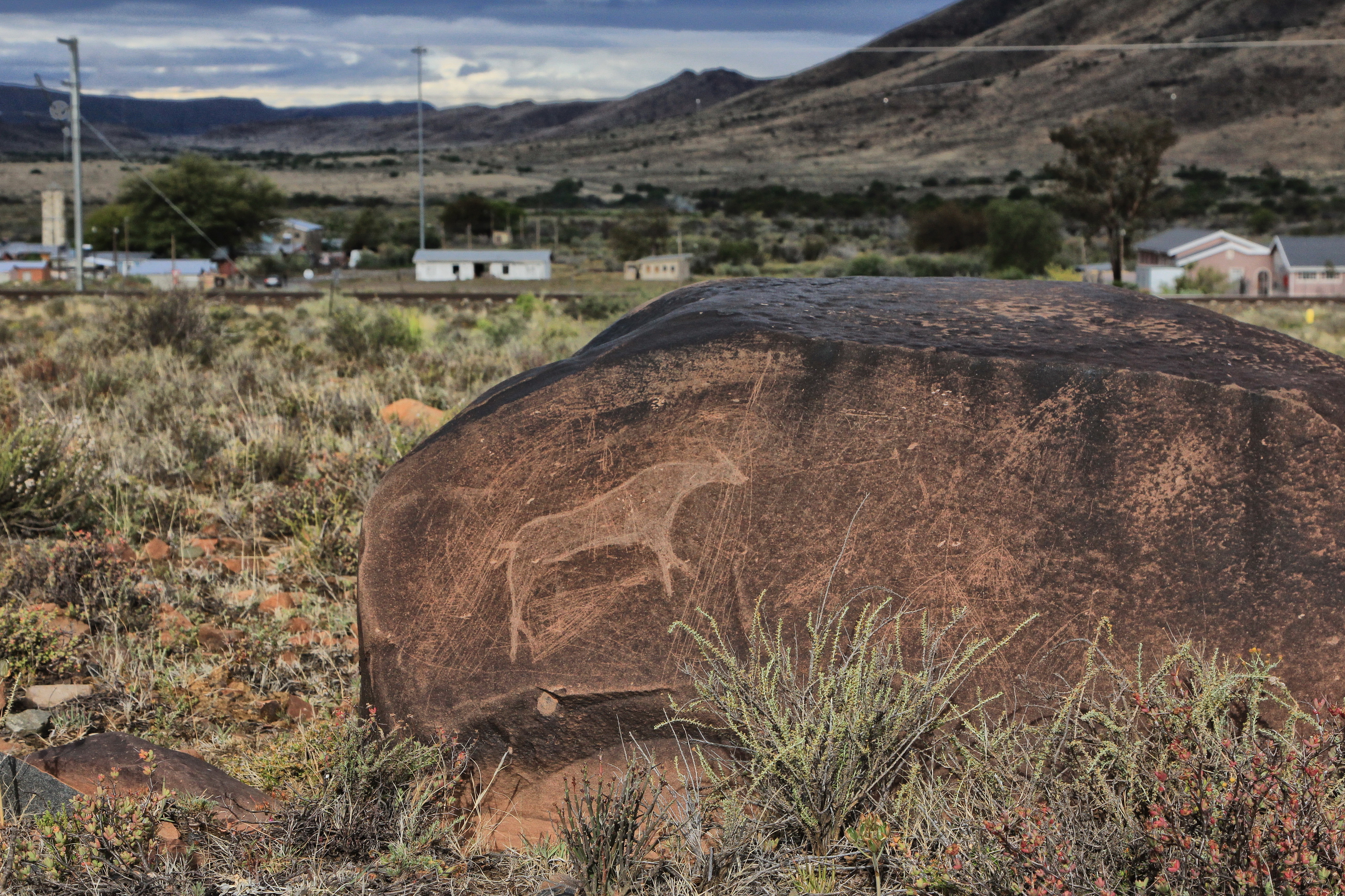
A simple blesbok engraving on a large dolerite rock, with Nelspoort in the background. Image: Chris Marais
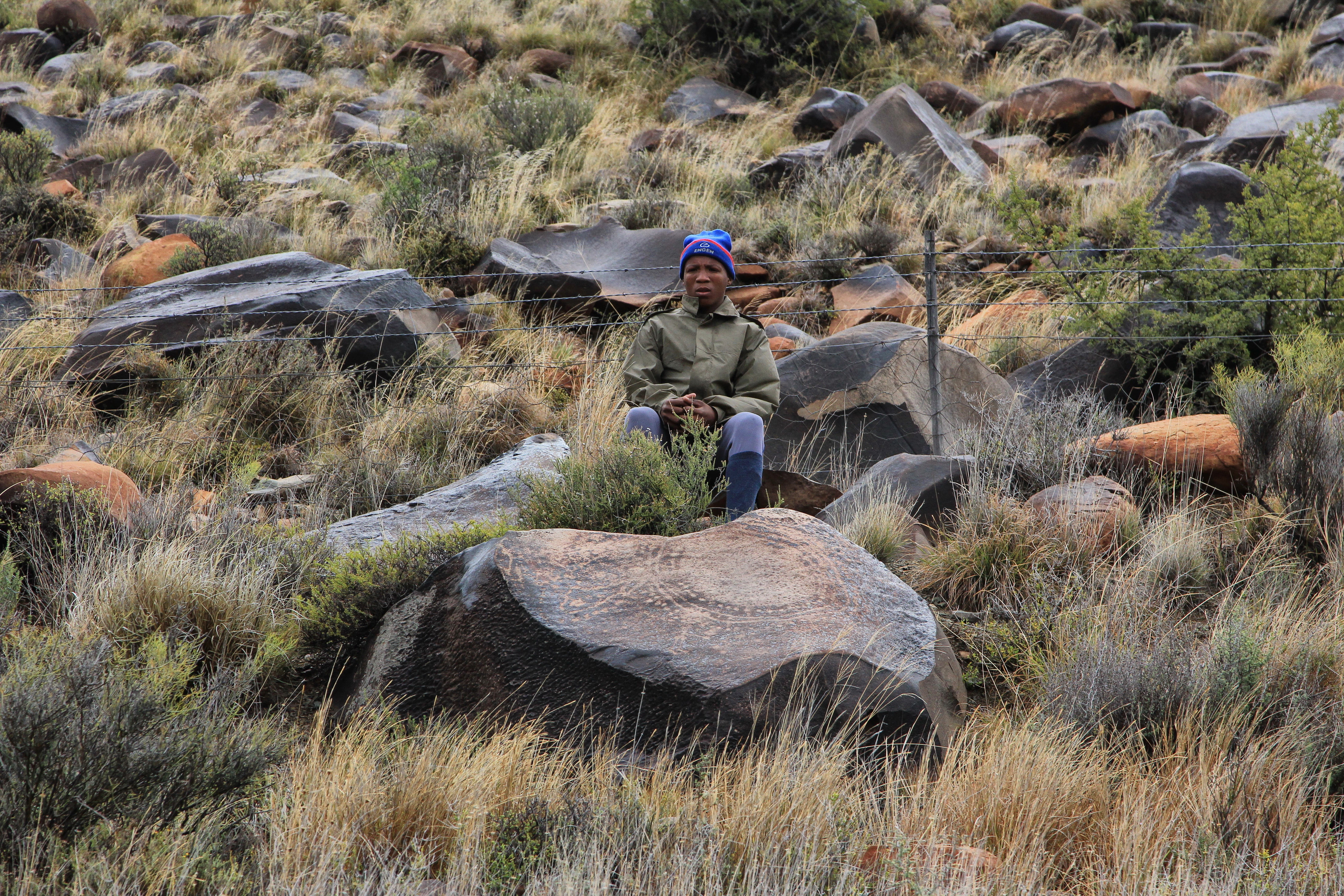
An intricate sunburst or tortoise pattern, possibly created by a Khoi (or Khoenkhoen) artist. Image: Chris Marais
Everyone etched the rocks
More recent ones, a few hundred years old, show paler geometrics, sunbursts, apron shapes, flower-like patterns. They are probably made by the Khoekhoen herders, also called ‘Khoi’ people.
A century or two ago, trekboers, European travellers, settlers and soldiers spent time here too, carving initials and images on the rocks. One of the most intriguing is of a man on a gallows and the words “Wiese, murder, 1865”, and the initials IB.
There are also engravings of trains, cars and women with skirts. But up until 2001, only one of these rock engravings was well-known. It resembles an extinct giant buffalo that probably vanished more than 10,000 years ago, Pelorovis antiquus. Fossils of this huge beast show it had horns up to three metres wide.
Modern rediscovery
The story of how many of these engravings were rediscovered just adds another layer of interesting history to Nelspoort.
In 2001, the principal of Nelspoort’s Restvale Primary School, Laurence Rathenam, had agreed to house and educate 25 street children from Beaufort West. One day, to tire them out, Laurence decided to take them for a long walk in the veld. A few kilometres north of the school, one of them spotted the figure of a little buck engraved onto one of dark rocks. Close by, there was another and another.
“From then on, the kids just wanted to go and look for more. They would call me, ‘Teach, Teach, here’s another one’. Their eyes are very sharp. They’re still discovering more all the time.”
After the first discoveries, Laurence contacted the National Museum in Bloemfontein. Sven Ouzman and Gabriel Thlapi from their Rock Art Department (Sven was later appointed curator of archaeology at Cape Town’s Iziko Museum) came to have a look.
The Skommerom Gang
Sven confirmed that the rocks had still more stories to tell.
“At six Nelspoort rock art sites there is something strange about the shiny black boulders. Some have either been broken by lightning or rest on top of other boulders. Some boulders, especially those near Bushman rock engravings, have hammer marks on them. Is this vandalism? Lightning? Acidic bird droppings? No. These marks represent sounds from the Bushman Spirit World.”
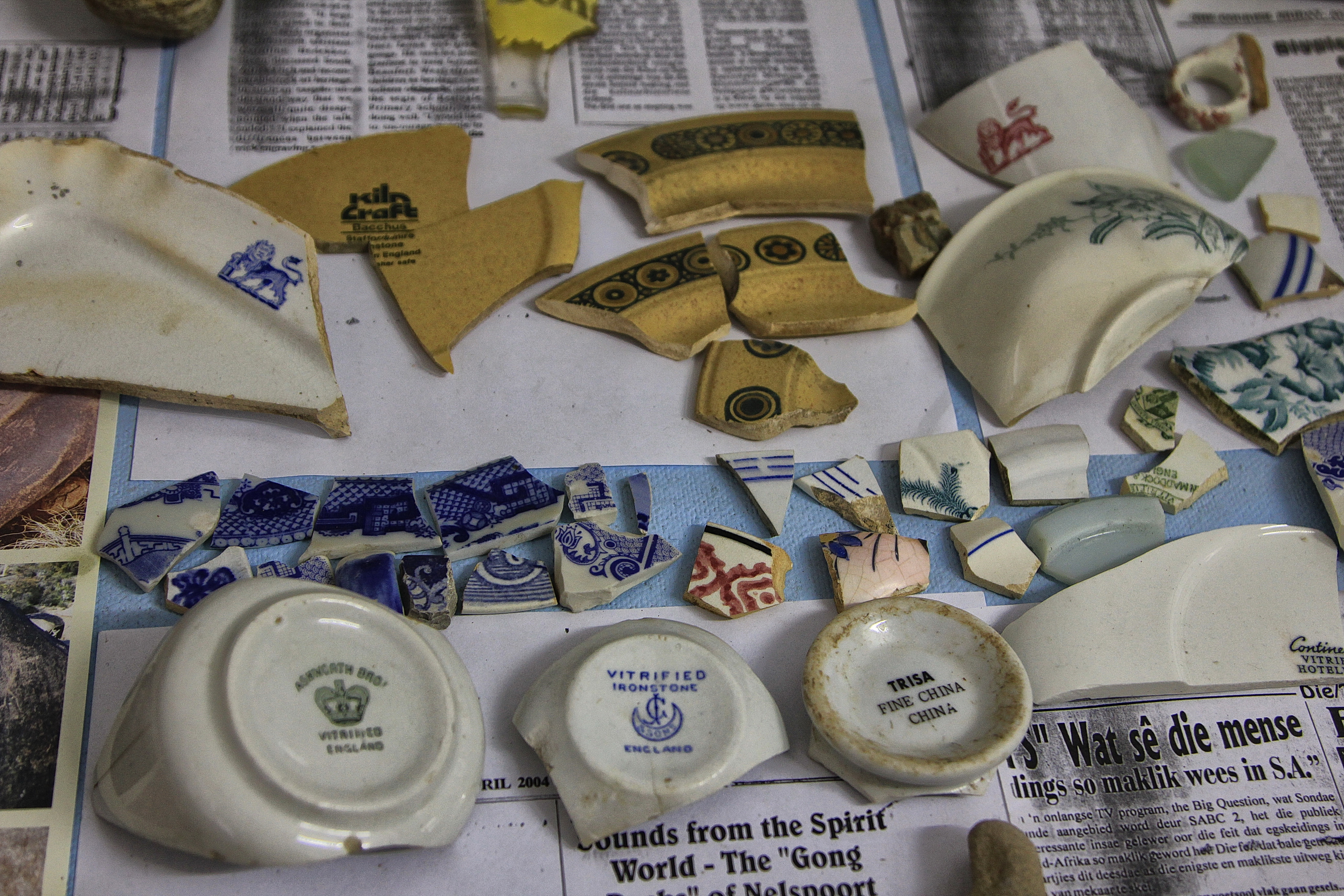
At Restvale Primary School, Laurence Rathenam and the children have created a little museum of objects found in the veld. Image: Chris Marais
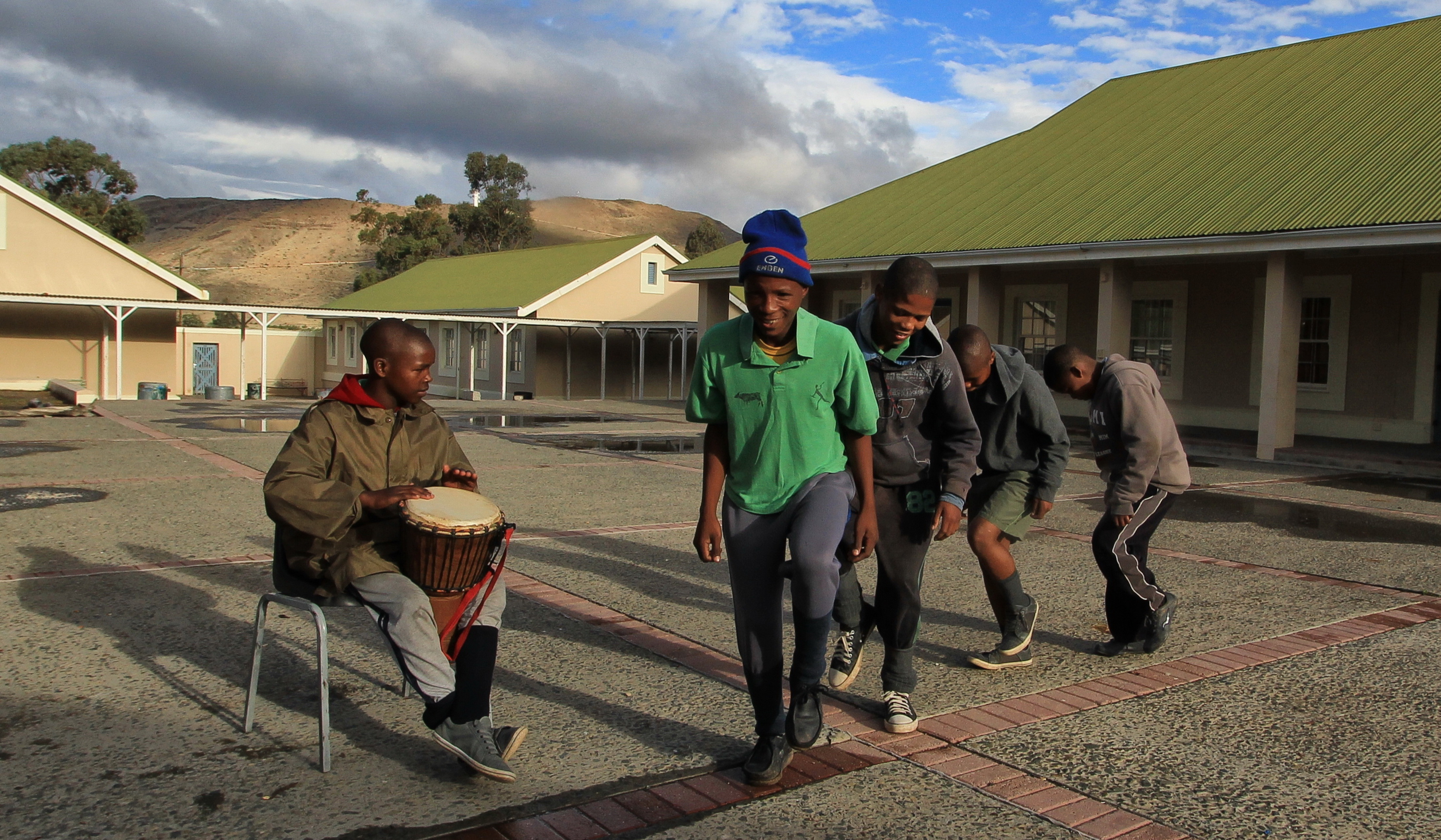
The members of the ‘Skommerom Gang’ of Restvale Primary School show off the moves and rhythms that won them a prize from the ATKV Nama Riel competition in 2009. Image: Chris Marais
Rathenam and his three protégés, – Elrico Adams (15), Shaun Gentels (16) and Patrick Hendriks (14) – took us up the hill and demonstrated what Sven Ouzman had described.
On the crest of the koppie, the boys waited for us, gathered around a long stone with the expectant air of organists in a church. Once we were ready, they struck the rocks with their cupped hands in a snaky, compelling rhythm, the same cadence that had won them a prize in a Nama Riel Dance competition as the Skommerom Gang in 2009.
This was a gong rock and it rang out clearly with a metallic bell-like sound that travelled over the long valley and the dry Sout River to the hills on the other side.
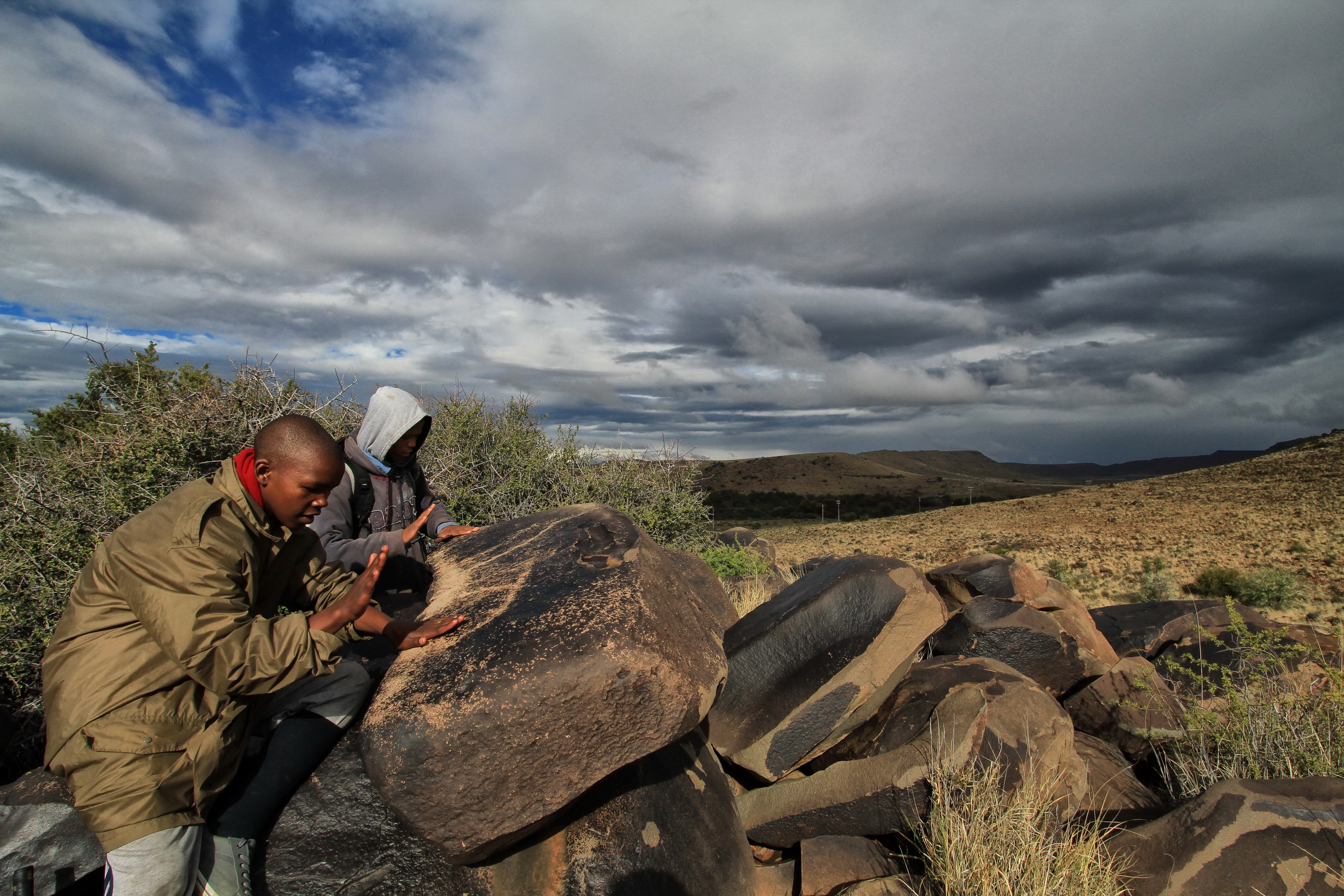
Drumming session – Elrico Adams and Shaun Gentels beating on a gong rock on the heights above Nelspoort. Image: Chris Marais
Street kids to art guides
“Just as cathedrals were built tall so that songs chanted inside them could rise to the heavens, rock gong are sited on hilltops so that their sounds travel across the vast surrounding landscape,” said Sven Ouzman. “The Karoo Bushmen believed these repetitive, percussive rhythms helped put them into an altered state of consciousness or ‘trance’ that let them enter the Spirit World they believed lay within the rock.
“Rock gongs let us imagine the landscape as a huge musical instrument resonant with meaning. The nearby rock art allows us to appreciate the deeply human and profoundly spiritual character of the stark and beautiful Karoo,” said Ouzman.
Street children from Beaufort West act as guides to the public, under the tuition and mentorship of Rathenam. This special task, of safeguarding and interpreting the history of the area, has given the boys an air of polite confidence.
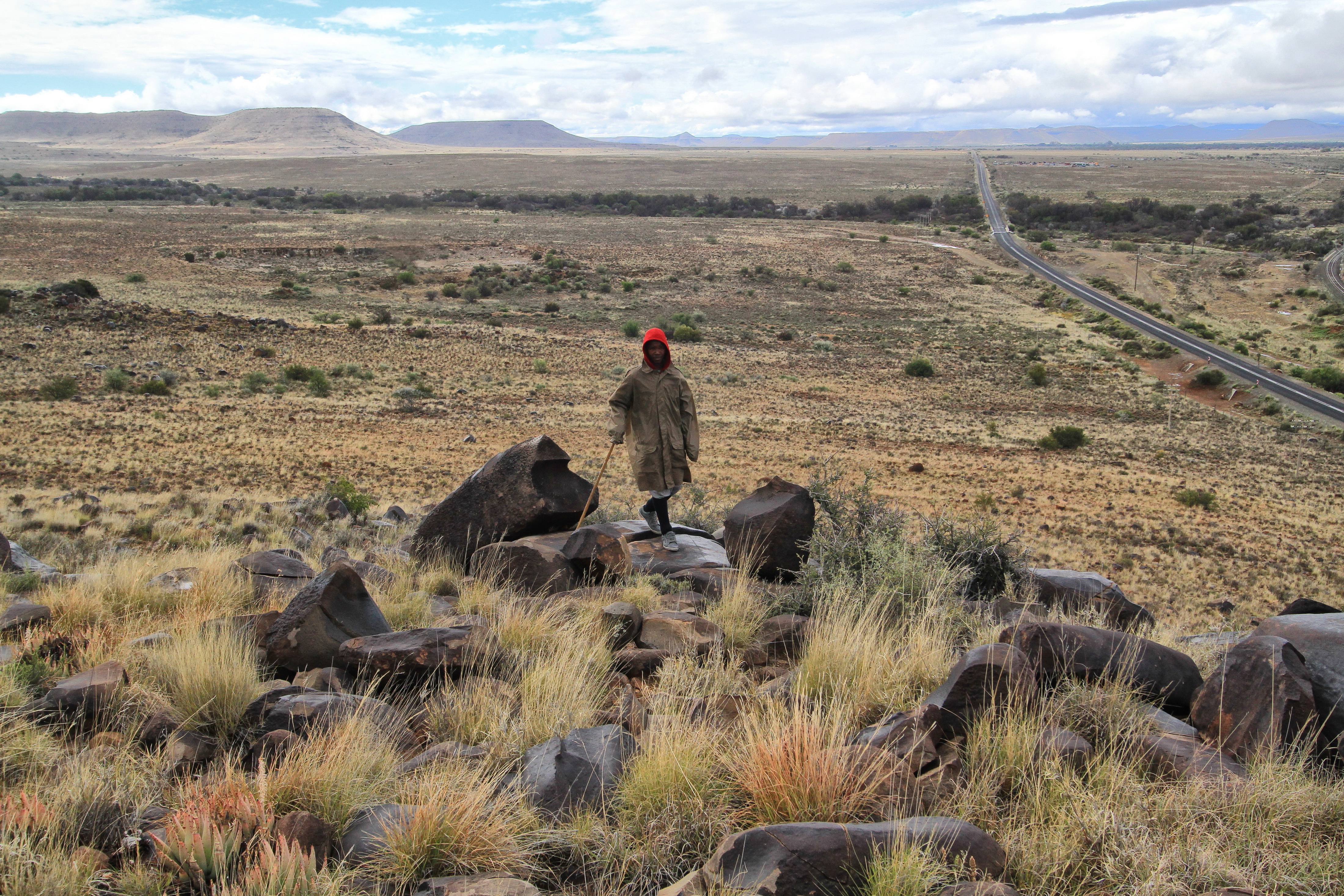
Elrico Adams waits to show us one of his rock engraving discoveries. Below is the road, the railway line and the line of trees marking the ephemeral river. On all sides are engraved rocks. Image: Chris Marais
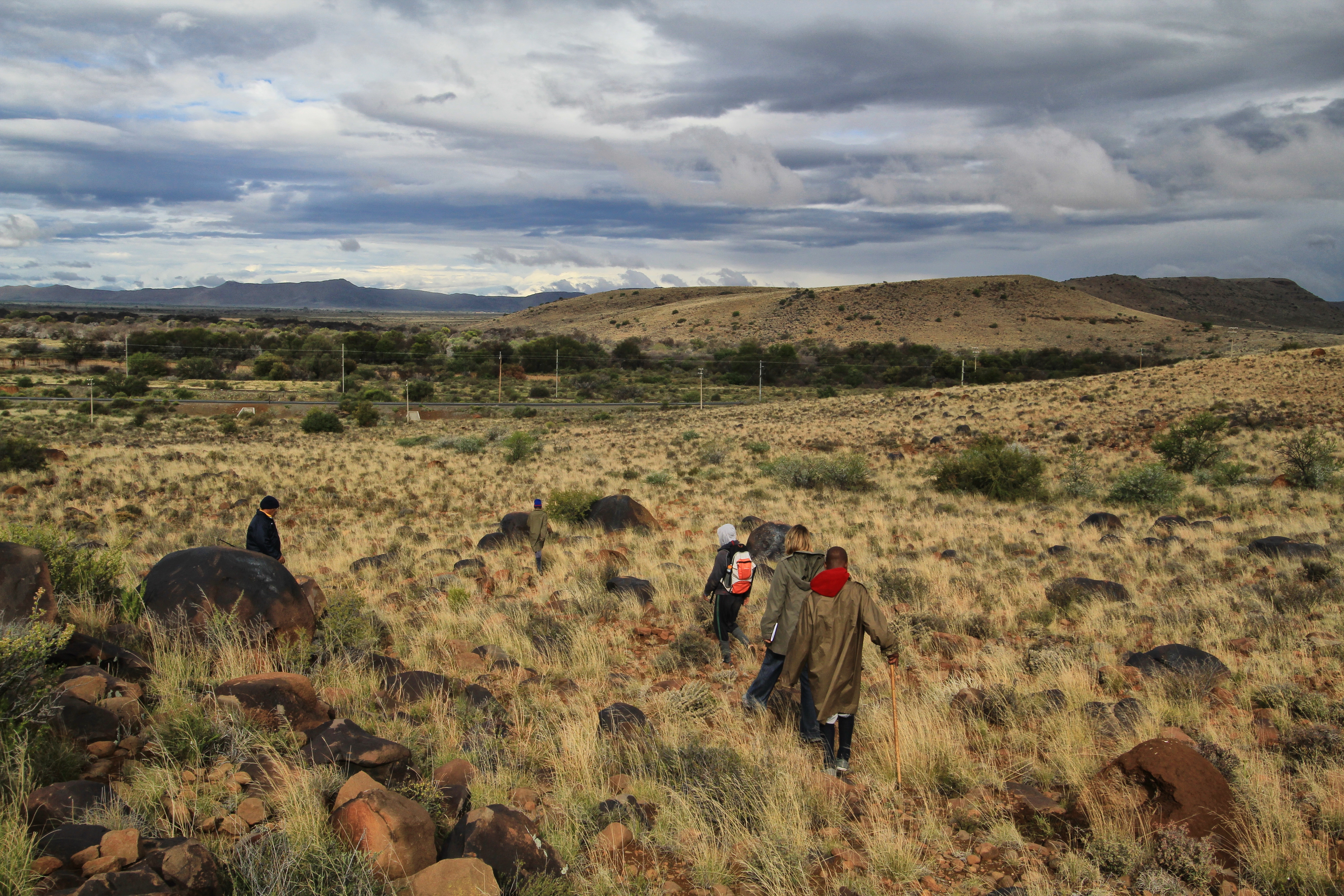
Laurence Rathenam and his charges take the author on a veld walk to see the rock engravings. Image: Chris Marais
Although the original children who had found the etchings have long since left Restvale, these three have found many more, and would often stand silently at ‘their’ discoveries until we’d had a look. Then they’d grin triumphantly and scamper like goats up rocky hillsides to the next one.
Patrick Hendriks dreams of one day becoming a lawyer, and Shaun Gentels wants to be a policeman. Elrico Adams doesn’t yet know what he wants to do, but he spots wild animals and birds long before anyone else. Maybe he’ll be a nature guide one day.
Laurence encourages their dreams. Over the years he’s lost some children back to the streets, but he and Nelspoort have turned things around for many others. The street children have returned the favour by changing Rathenam’s life, and Nelspoort’s history. DM/ML
This is an extract from Karoo Roads I – Tales from South Africa’s Heartland, by Chris Marais and Julienne du Toit.
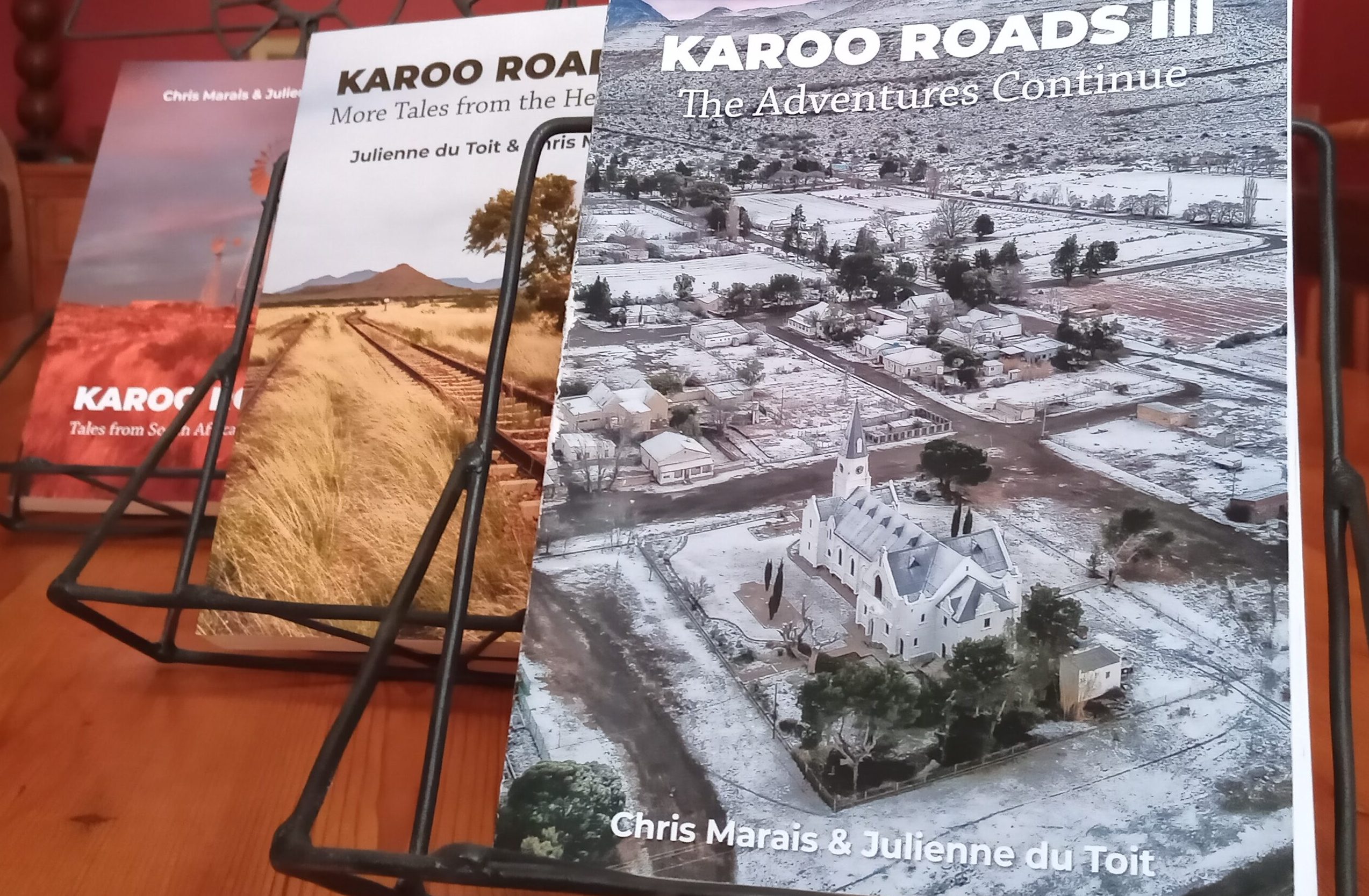
‘Karoo Roads’ Collection. Image: Chris Marais
For an insider’s view on life in the Dry Country, get the three-book special of Karoo Roads I, Karoo Roads II and Karoo Roads III for only R800, including courier costs in South Africa. For more details, contact Julie at [email protected]










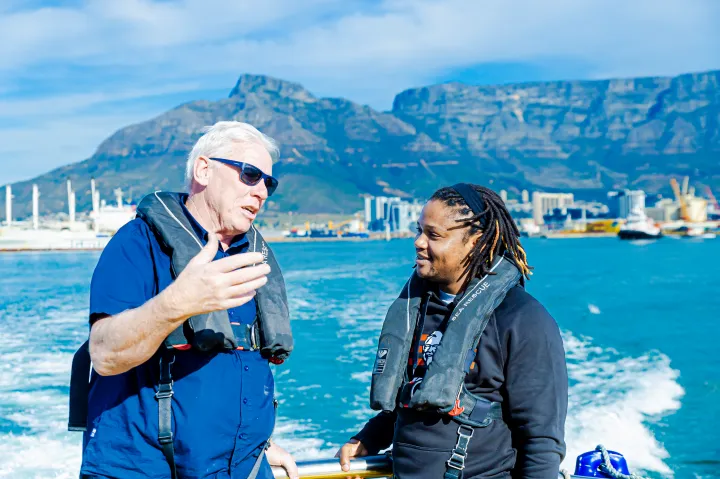




Exceptional place, and wonderful man for the work he does there with the schoolkids.
Wonderful story of hope and a legacy being preserved.
Fascinating story!
It’s so good to hear these stories about kindness and beauty.